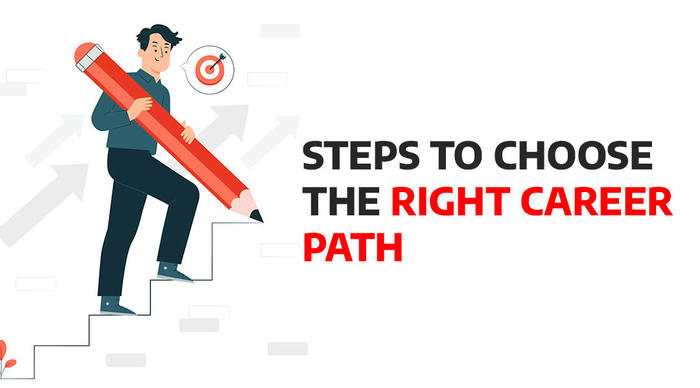How to Choose the Right Career for Yourself
Selecting a career path is one of the most consequential decisions in life, yet many individuals struggle to align their passions, skills, and financial goals. In a rapidly evolving job market, where automation and globalization reshape industries, making an informed choice requires introspection, research, and adaptability. This article provides a structured framework to help you identify a career that resonates with your strengths, values, and aspirations while ensuring long-term viability.

1. Conduct a Comprehensive Self-Assessment
Understanding yourself is the foundation of career alignment. Break down your evaluation into four key areas:
A. Interests and Passions
Identify activities that energize you. For example:
•Do you thrive in collaborative environments or prefer independent work?
•Are you drawn to creative, analytical, or hands-on tasks?
Tools like the Holland Code (RIASEC) assessment categorize interests into six types (Realistic, Investigative, Artistic, Social, Enterprising, Conventional) to match careers. A teacher might score high in “Social,” while an engineer may align with “Investigative.”
B. Core Values
Your values shape job satisfaction. Prioritize factors such as:
•Work-life balance vs. high earnings.
•Social impact vs. corporate advancement.
•Stability vs. entrepreneurial risk.
A 2022 McKinsey survey found that 70% of employees prioritize purpose over salary, highlighting the importance of value-driven careers.
C. Skills and Strengths
Audit both hard and soft skills:
•Technical abilities: Coding, data analysis, or language proficiency.
•Transferable skills: Leadership, problem-solving, or communication.
Platforms like CliftonStrengths help identify innate talents, such as strategic thinking or relationship-building.
D. Personality Traits
Assess how your temperament fits workplace cultures. Introverts may excel in research roles, while extroverts might thrive in sales or PR. The Myers-Briggs Type Indicator (MBTI) is a widely used tool for this purpose.
Action Step: Create a SWOT analysis (Strengths, Weaknesses, Opportunities, Threats) to synthesize your findings.
2. Research Industries and Market Trends
Even fulfilling careers can become obsolete. Prioritize fields with growth potential:
A. High-Demand Sectors
•Healthcare: Aging populations drive demand for nurses, physical therapists, and gerontologists. The U.S. Bureau of Labor Statistics (BLS) projects a 15% growth in healthcare occupations by 2032.
•Technology: AI, cybersecurity, and renewable energy are rapidly expanding. Roles like data scientists and sustainability managers offer median salaries exceeding $100,000.
•Skilled Trades: Electricians and HVAC technicians face worker shortages, with salaries rising due to demand.
B. Future-Proof Roles
Automation-resistant careers often require human-centric skills. For instance:
•Healthcare providers: Empathy and decision-making cannot be replicated by AI.
•Education and Training: Teachers and corporate trainers remain critical for skill development.
Action Step: Use resources like the BLS Occupational Outlook Handbook or LinkedIn’s Jobs on the Rise reports to identify thriving industries.
3. Gain Hands-On Experience
Theoretical knowledge alone rarely confirms career suitability. Practical exposure helps validate choices:
A. Internships and Apprenticeships
•Short-term internships in fields like finance or engineering provide insider perspectives.
•Apprenticeships in trades (e.g., plumbing, coding bootcamps) combine paid training with skill-building.
B. Job Shadowing and Informational Interviews
Spend a day with professionals in target roles. Ask about daily challenges, rewards, and career trajectories.
C. Volunteer Work and Freelancing
Nonprofits and startups often offer opportunities to test skills in project management, marketing, or event planning.
Action Step: Dedicate 3–6 months to exploratory experiences before committing to a career path.
4. Invest in Education and Skill Development
Once you’ve narrowed options, acquire qualifications that make you competitive:
A. Formal Education
•Degrees: A bachelor’s in computer science opens doors to tech roles, while a master’s in social work is essential for clinical positions.
•Certifications: PMP for project managers, CFA for finance professionals.
B. Alternative Pathways
•Online courses: Platforms like Coursera and edX offer programs from top universities.
•Workshops and Bootcamps: Intensive programs in coding (e.g., Le Wagon) or digital marketing (e.g., General Assembly) provide job-ready skills.
Action Step: Compare program outcomes—employment rates, alumni networks—before enrolling.
5. Evaluate Financial and Lifestyle Factors
A fulfilling career must also sustain your desired lifestyle:
A. Salary and Benefits
Research median salaries for target roles using Glassdoor or Payscale. Consider long-term earnings growth, not just entry-level pay.
B. Work Environment
•Office-based vs. remote/hybrid roles.
•Travel requirements or irregular hours (common in healthcare or journalism).
C. Geographic Flexibility
Some careers, like academia or acting, may require relocation for opportunities.
Action Step: Draft a 5-year financial plan incorporating student loans, living costs, and savings goals.
6. Make an Informed Decision
Synthesize your research into a pros-and-cons analysis:
•Shortlist 2–3 Careers: Align with your SWOT analysis and market data.
•Consult Mentors: Seek advice from industry professionals or career coaches.
•Test-Drive: Pursue part-time roles or contract work before full commitment.
Case Study: From Uncertainty to Clarity
James, a recent biology graduate, felt torn between medical school and environmental advocacy. He:
•Shadowed a physician and volunteered at a climate NGO.
•Discovered his passion for science communication over clinical work.
•Pursued a master’s in environmental policy and now advises NGOs on sustainability strategies.
Avoiding Common Pitfalls
Overvaluing Prestige: A “glamorous” job may not suit your temperament.
Ignoring Burnout Risks: High-stress roles in law or finance require resilience.
Rushing the Process: Career clarity often emerges through trial and error.
Conclusion: Crafting Your Career Narrative
Choosing the right career is an iterative journey, not a one-time decision. By systematically assessing your strengths, exploring industries, and gaining real-world experience, you can align your professional path with personal fulfillment and economic stability. Remember, careers are rarely linear—stay open to pivots as your goals and the market evolve.
Invest time in self-discovery, leverage accessible resources, and approach each step with curiosity. Ultimately, the right career is one where your skills meet the world’s needs, creating a legacy of purpose and growth.
